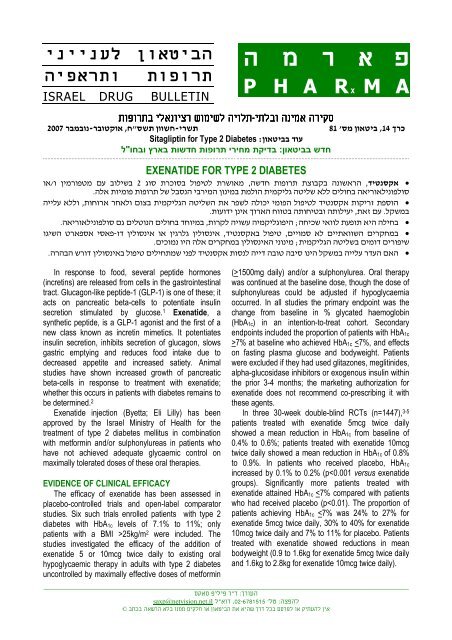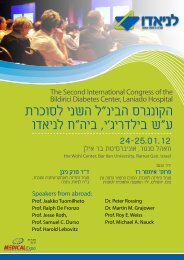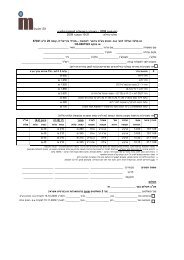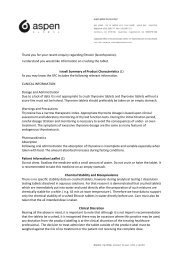exenatide for type 2 diabetes
exenatide for type 2 diabetes
exenatide for type 2 diabetes
Create successful ePaper yourself
Turn your PDF publications into a flip-book with our unique Google optimized e-Paper software.
__________________________________________________________________________________________________________<br />
בכתב ©<br />
העורך: ד"ר פיליפ סאקס<br />
דוא"ל<br />
להפצה: טל'<br />
אין להעתיק או לפרסם בכל דרך שהיא את הביטאון או חלקים ממנו בלא הרשאה<br />
saxp@netvision.net.il<br />
ה<br />
P H A R x M A<br />
,02-6781515<br />
מ ר א פ<br />
הביטאון לענייני<br />
תרופות ותראפיה<br />
ISRAEL DRUG BULLETIN<br />
כרך 14, ביטאון מס' 81<br />
לשימוש רציונאלי בתרופות<br />
אמינה ובלתי ובלתי-תלויה<br />
סקירה<br />
תשרי-חשוון תשס"ח, אוקטובר-נובמבר 2007<br />
עוד בביטאון: Sitagliptin <strong>for</strong> Type 2 Diabetes<br />
חדש בביטאון: בדיקת מחירי תרופות חדשות בארץ ובחו"ל<br />
............................................................................................................................... ..................................................................................................................<br />
EXENATIDE FOR TYPE 2 DIABETES<br />
אקסנטיד, הראשונה בקבוצת תרופות חדשה, מאושרת לטיפול בסוכרת סוג בשילוב עם מטפורמין ו/או<br />
סולפונילאוריאה בחולים ללא שליטה גליקמית הולמת במינון המירבי הנסבל של תרופות פומיות אלה.<br />
הוספת זריקות אקסנטיד לטיפול הפומי יכולה לשפר את השליטה הגליקמית בצום ולאחר ארוחות, וללא עלייה<br />
במשקל. עם זאת, יעילותה ובטיחותה בטווח הארוך אינן ידועות.<br />
בחילה היא תופעת לוואי שכיחה; היפוגליקמיה עשויה לקרות, במיוחד בחולים הנוטלים גם סולפונילאוריאה.<br />
במחקרים השוואתיים לא סמויים, טיפול באקסנטיד, אינסולין גלרגין או אינסולין דו-פאסי אספארט השיגו<br />
שיפורים דומים בשליטה הגליקמית; מינוני האינסולין במחקרים אלה היו נמוכים.<br />
• האם העדר עלייה במשקל הינו סיבה טובה דייה לנסות אקסנטיד לפני שמתחילים טיפול באינסולין דורש הבהרה.<br />
In response to food, several peptide hormones<br />
(incretins) are released from cells in the gastrointestinal<br />
tract. Glucagon-like peptide-1 (GLP-1) is one of these; it<br />
acts on pancreatic beta-cells to potentiate insulin<br />
secretion stimulated by glucose. 1 Exenatide, a<br />
synthetic peptide, is a GLP-1 agonist and the first of a<br />
new class known as incretin mimetics. It potentiates<br />
insulin secretion, inhibits secretion of glucagon, slows<br />
gastric emptying and reduces food intake due to<br />
decreased appetite and increased satiety. Animal<br />
studies have shown increased growth of pancreatic<br />
beta-cells in response to treatment with <strong>exenatide</strong>;<br />
whether this occurs in patients with <strong>diabetes</strong> remains to<br />
be determined. 2<br />
Exenatide injection (Byetta; Eli Lilly) has been<br />
approved by the Israel Ministry of Health <strong>for</strong> the<br />
treatment of <strong>type</strong> 2 <strong>diabetes</strong> mellitus in combination<br />
with met<strong>for</strong>min and/or sulphonylureas in patients who<br />
have not achieved adequate glycaemic control on<br />
maximally tolerated doses of these oral therapies.<br />
EVIDENCE OF CLINICAL EFFICACY<br />
The efficacy of <strong>exenatide</strong> has been assessed in<br />
placebo-controlled trials and open-label comparator<br />
studies. Six such trials enrolled patients with <strong>type</strong> 2<br />
<strong>diabetes</strong> with HbA 1c levels of 7.1% to 11%; only<br />
patients with a BMI >25kg/m 2 were included. The<br />
studies investigated the efficacy of the addition of<br />
<strong>exenatide</strong> 5 or 10mcg twice daily to existing oral<br />
hypoglycaemic therapy in adults with <strong>type</strong> 2 <strong>diabetes</strong><br />
uncontrolled by maximally effective doses of met<strong>for</strong>min<br />
2<br />
(>1500mg daily) and/or a sulphonylurea. Oral therapy<br />
was continued at the baseline dose, though the dose of<br />
sulphonylureas could be adjusted if hypoglycaemia<br />
occurred. In all studies the primary endpoint was the<br />
change from baseline in % glycated haemoglobin<br />
(HbA 1c) in an intention-to-treat cohort. Secondary<br />
endpoints included the proportion of patients with HbA 1c<br />
>7% at baseline who achieved HbA 1c
A total of 974 patients who had completed one of<br />
the above studies enrolled in an open-label extension<br />
study during which all patients received <strong>exenatide</strong><br />
10mcg twice daily. 6 Of the patients who completed two<br />
years of <strong>exenatide</strong> treatment, the reduction in HbA 1c<br />
was maintained and weight loss continued. However,<br />
the withdrawal rate was high and only 283 patients<br />
completed two years of <strong>exenatide</strong> treatment.<br />
In two of the above trials <strong>exenatide</strong> was added to<br />
oral monotherapy. 3,4 However, it is more likely that in<br />
clinical practice <strong>exenatide</strong> will be added to treatment<br />
once combination therapy with two (and possibly three)<br />
oral hypoglycaemics has failed.<br />
A 16-week placebo-controlled RCT in 233 patients<br />
with <strong>type</strong> 2 <strong>diabetes</strong> on glitazone treatment with or<br />
without met<strong>for</strong>min found <strong>exenatide</strong> 10mcg twice daily<br />
reduced HbA 1c levels to a greater extent than placebo (-<br />
0.9% vs +0.1%; p25kg/m 2 and were on<br />
combination therapy with met<strong>for</strong>min and a<br />
sulphonylurea.<br />
The change in HbA 1c in the <strong>exenatide</strong> group was<br />
found to be non-inferior to that in the insulin glargine<br />
group (both -1.1%) and the biphasic insulin aspart<br />
group (-1.0% vs. -0.9%). In order to prove clinical noninferiority<br />
to insulin, it must be proven that insulin<br />
treated subjects had maximally tolerated doses of<br />
insulin. 10 This is doubtful and that, based on the nonblinded<br />
nature of these studies, a potential bias towards<br />
lower doses of insulin cannot be fully excluded, even<br />
though an attempt to minimise this bias was made. The<br />
proportion of patients achieving the target HbA 1c was<br />
46% <strong>for</strong> <strong>exenatide</strong> compared with 48% <strong>for</strong> insulin<br />
glargine, and 32% <strong>for</strong> <strong>exenatide</strong> and 24% with biphasic<br />
insulin aspart. Patients treated with <strong>exenatide</strong> lost<br />
bodyweight (2.3 to 2.5kg) whereas patients treated with<br />
insulin glargine or biphasic insulin aspart gained<br />
bodyweight.<br />
ADVERSE EFFECTS<br />
The main adverse effects of <strong>exenatide</strong> are nausea,<br />
vomiting, diarrhoea, and hypoglycaemia. In comparator<br />
studies, the incidence of nausea ranged from 33% to<br />
57% in <strong>exenatide</strong> groups compared with 0.4% to 9% in<br />
patients treated with insulin analogues; <strong>for</strong> vomiting the<br />
equivalent rates were 9% to 17% and 2.4% to 4%<br />
respectively. Most episodes of nausea were mild to<br />
moderate, dose-related, and decreased in frequency<br />
with continued treatment. There have been reports of<br />
pancreatitis in postmarketing surveillance data. 10,11<br />
The incidence of hypoglycaemia with <strong>exenatide</strong><br />
increased when used in combination with a<br />
sulphonylurea, but not met<strong>for</strong>min. A reduction in the<br />
sulphonylurea dose should be considered when giving<br />
in combination with <strong>exenatide</strong> and blood glucose<br />
monitoring may become necessary. In comparator<br />
studies, the incidence of hypoglycaemia was<br />
comparable in <strong>exenatide</strong>– and insulin-treated groups.<br />
Some patients developed anti-<strong>exenatide</strong> antibodies,<br />
which did not increase the incidence of any adverse<br />
effects, but in a few patients appeared to attenuate the<br />
anti-hyperglycaemic effect of the drug.<br />
More <strong>exenatide</strong>-treated patients withdrew from the<br />
studies because of adverse events compared with<br />
patients treated with insulin glargine 9 (10% vs 1%) or<br />
biphasic insulin aspart (8% vs 0%). 8 In pregnant<br />
animals, <strong>exenatide</strong> at 3 times the human dose had<br />
adverse effects on the foetus, including reduced growth,<br />
skeletal abnormalities and teratogenic effects. It should<br />
not be used during pregnancy.<br />
Drug interactions: Because the drug slows gastric<br />
emptying, <strong>exenatide</strong> may reduce the extent and rate of<br />
absorption of some oral medicines. Patients receiving<br />
oral medicines with a narrow therapeutic range or those<br />
requiring careful monitoring should be followed closely.<br />
Oral medicines dependent on threshold concentrations,<br />
e.g. contraceptives or antibiotics, should be taken at<br />
least one hour be<strong>for</strong>e <strong>exenatide</strong>. Increased INR has<br />
been reported during concomitant use with warfarin.<br />
DOSAGE AND COSTS<br />
Therapy should be initiated at 5mcg twice daily <strong>for</strong><br />
at least one month to improve tolerability, then<br />
increased to 10mcg twice daily to further improve<br />
glycaemic control. Doses should be administered<br />
subcutaneously in the thigh, abdomen or upper arm at<br />
any time within one hour be<strong>for</strong>e the morning and<br />
evening meals (or two main meals approximately 6<br />
hours or more apart) and should not be administered<br />
after a meal. Exenatide is not recommended <strong>for</strong><br />
patients with severe renal impairment (CrCl
Cost of Exenatide and Insulins<br />
Drug Dose 1 Cost (NIS) 2<br />
Exenatide (Byetta) 5-10mcg twice 805<br />
daily<br />
Isophane insulin 25-50U daily 112-223<br />
(Humulin 30/70 /<br />
Insulatard)<br />
Biphasic insulin aspart 25-50U daily 156-312<br />
(Novomix 30)<br />
Insulin glargine (Lantus) 25-50U daily 217-434<br />
Insulin detemir (Levemir) 25-50U daily 223-447<br />
1<br />
Doses are <strong>for</strong> general comparison only and do not imply therapeutic<br />
equivalence.<br />
2<br />
30 days; cartridge costs at retail price.<br />
International cost comparison (monthly cost at.<br />
price to retail pharmacy): Israel NIS 593; UK NIS 560<br />
(₤1 = NIS 8.2), <strong>for</strong> both strengths. In the USA: NIS 588<br />
(1.2ml pen), NIS 690 (2.4ml pen) (USD = NIS 4.0).<br />
Comparing prices in Israel with drug prices in the UK<br />
and USA is instructive, as prices in these countries are<br />
usually higher than elsewhere. Furthermore, the UK<br />
and USA are much higher income countries than Israel,<br />
meaning they are better able to fund the cost of new<br />
drugs.<br />
CONCLUSION<br />
Adding twice daily injections of <strong>exenatide</strong> to oral<br />
therapy was seen to reduce HbA 1c levels to a greater<br />
extent than placebo. Non-blinded comparator studies<br />
found <strong>exenatide</strong> to be non-inferior to insulin glargine or<br />
biphasic insulin aspart in reducing HbA 1c levels;<br />
however, insulin doses in these studies were low.<br />
Nausea is common, and hypoglycaemia can occur,<br />
particularly in patients also taking a sulphonylurea.<br />
There are no data on the effects of <strong>exenatide</strong> on<br />
mortality or morbidity outcomes. Further long-term data<br />
are needed to establish safety and if short-term<br />
improvements in HbA 1c are sustained. Weight loss with<br />
<strong>exenatide</strong>, which appears to be directly proportional to<br />
baseline BMI is an important advantage over insulin in<br />
overweight patients. Whether the absence of weight<br />
gain is reason enough to try it be<strong>for</strong>e starting insulin<br />
remains to be seen. It has no advantage over insulin in<br />
terms of the number of daily injections required.<br />
The dose of <strong>exenatide</strong> does not need to be adjusted<br />
on a day to day basis. However, blood glucose<br />
monitoring may still be necessary to adjust the dose of<br />
sulphonylureas.<br />
References<br />
1. Davidson M et al, Nature Reviews Drug Discovery 4:713,<br />
2005.<br />
2. Joy S et al, Ann Pharmacother 39:110, 2005.<br />
3. De Fronzo R et al, Diabetes Care 28:1092, 2005.<br />
4. Buse J et al, Diabetes Care 27:2628, 2004.<br />
5. Kendall D et al, Diabetes Care 28:1083, 2005.<br />
6. Buse J et al, Clin Ther 29:139, 2007.<br />
7. Zinman B et al, Ann Intern Med 146:477, 2007<br />
8. Nauck M et al, Diabetologia 50:259, 2007.<br />
9. Heine R et al, Ann Intern Med 143:559, 2005.<br />
10. European public assessment report (Byetta), December<br />
2006.<br />
11. www.fda.gov/cder/drug/In<strong>for</strong>sheets/HCP/<strong>exenatide</strong>HCP,<br />
16.10.07.<br />
............................................................................................................................... ..................................................................................................................<br />
SITAGLIPTIN FOR TYPE 2 DIABETES<br />
נראה שסיטאגליפטין, הראשונה בקבוצת תרופות חדשה לטיפול בסוכרת סוג הינה בעלת יעילות בינונית הן<br />
בטיפול יחיד והן בשילוב עם תרופות אנטי סוכרתיות אחרות.<br />
עד היום לא נצפה קשר לעלייה במשקל או להיפוגליקמיה. ואולם, הניסיון הקליני עם סיטגליפטין מוגבל ובטיחותה<br />
ארוכת הטווח אינה ידועה.<br />
יעילותה של סיטאגליפטין בהשוואה לתרופות ותיקות יותר עדיין דורשת ביסוס. נראה כי מטפורמין<br />
וסולפונילאוריאה יעילות יותר בהורדת רמות HbA 1c בטווח הקצר והן זולות בהרבה.<br />
סיטאגליפטון נמצאת בהליכי רישום במשרד הבריאות.<br />
,2<br />
•<br />
•<br />
•<br />
•<br />
Sitagliptin (Januvia; MSD) is the first of a new class<br />
of oral antidiabetic agents known as dipeptidyl<br />
peptidase <strong>type</strong> 4 (DPP-4) inhibitors. They enhance the<br />
levels of active incretin hormones (including glucagonlike<br />
peptide-1 [GLP-1]), which are released by the<br />
intestine steadily throughout the day and are increased<br />
in response to a meal. Incretin hormones enhance<br />
insulin secretion, reduce glucagon secretion, and so<br />
reduce blood glucose levels. However, they are rapidly<br />
inactivated by the DPP-4 enzyme. DPP-4 inhibitors help<br />
to prevent this inactivation. 1<br />
Sitagliptin has been approved in the EU and USA in<br />
combination with met<strong>for</strong>min or thiazolidinediones, such<br />
as rosiglitazone, when monotherapy with these agents<br />
does not provide adequate glycaemic control. In the<br />
USA it is also licensed <strong>for</strong> use in combination with<br />
sulphonylurea or as part of a triple therapy regimen. It<br />
has also been approved as monotherapy in the USA.<br />
Here we assess sitagliptin's efficacy as monotherapy<br />
and as part of combination therapy.<br />
_______________________________________________________________________________________________________________________<br />
81 ,14 אוקטובר-נובמבר 2007<br />
3<br />
פארמה, כרך<br />
ביטאון מס'
Pharmacokinetics: Sitagliptin is rapidly absorbed;<br />
plasma concentrations reach a peak 1-4 hours after<br />
ingestion. A single 100mg dose inhibits DPP-4 activity<br />
over a 24-hour period and increases glucose- or mealstimulated<br />
plasma GLP-1 and glucose-dependent<br />
insulinotropic polypeptide (GIP) levels about 2- to 3-<br />
fold. 2<br />
EVIDENCE OF CLINICAL EFFICACY<br />
Monotherapy<br />
In two double-blind, placebo-controlled studies of 18<br />
weeks' (n=521) and 24 weeks' (n=741) duration in<br />
patients with <strong>type</strong> 2 <strong>diabetes</strong> not controlled by diet and<br />
exercise, sitagliptin 100mg once daily was associated<br />
with reductions in HbA 1c of 0.48% and 0.61% from<br />
baseline, compared to an increase of 0.12% and 0.18%<br />
with placebo. 3,4 These decreases in HbA 1c are less than<br />
those generally expected with met<strong>for</strong>min (1.5%),<br />
sulfonylureas (1.5%) or thiazolidinediones (0.5%-<br />
1.4%). 5 Significantly (p
ADVERSE EFFECTS<br />
Adverse events reported in the trials included<br />
nasopharyngitis, urinary tract infection, abdominal pain<br />
and headache. 6-9 One concern is that many other peptides<br />
besides the incretin hormones, including neuropeptides,<br />
cytokines and chemokines, are metabolised by the<br />
relatively nonspecific DPP-4 enzyme. 11 Whether inhibiting<br />
this activity could have untoward effects is unknown. 12<br />
There are no published safety data beyond 52 weeks <strong>for</strong><br />
sitagliptin.<br />
Safety data <strong>for</strong> sitagliptin used in combination therapy<br />
suggest that the overall incidence of gastrointestinal<br />
adverse events was similar to placebo 6 and glipizide 8<br />
when added to ongoing met<strong>for</strong>min, but higher than<br />
placebo (13.7% vs 6.2%) when added to ongoing<br />
pioglitazone. 9 The addition of sitagliptin to met<strong>for</strong>min or<br />
pioglitazone did not significantly increase the incidence of<br />
hypoglycaemia vs placebo, 6,9 and fewer patients reported<br />
hypoglycaemic episodes (of any severity) with sitagliptin<br />
(4.9%) vs glipizide (32.0%, p







